CHC50113 Diploma: Inclusion Plan, Cooperative Behavior, Partnerships
VerifiedAdded on 2023/06/17
|57
|13694
|124
Project
AI Summary
This assignment solution provides a detailed exploration of developing and implementing an inclusion plan within an early childhood education setting, specifically addressing the needs of a child named Zian. The project covers various aspects, including identifying potential developmental and health concerns based on a provided case study, gathering additional information from medical professionals, and supporting the child's and family's enrollment and orientation process. It also delves into the legal considerations, such as the Disability Discrimination Act 1992, and emphasizes the importance of working in partnership with families to provide appropriate education and care. Furthermore, the assignment includes creating a behavior observation and analysis, along with a behavior plan tailored to the child's specific needs, ensuring a comprehensive approach to inclusive education.
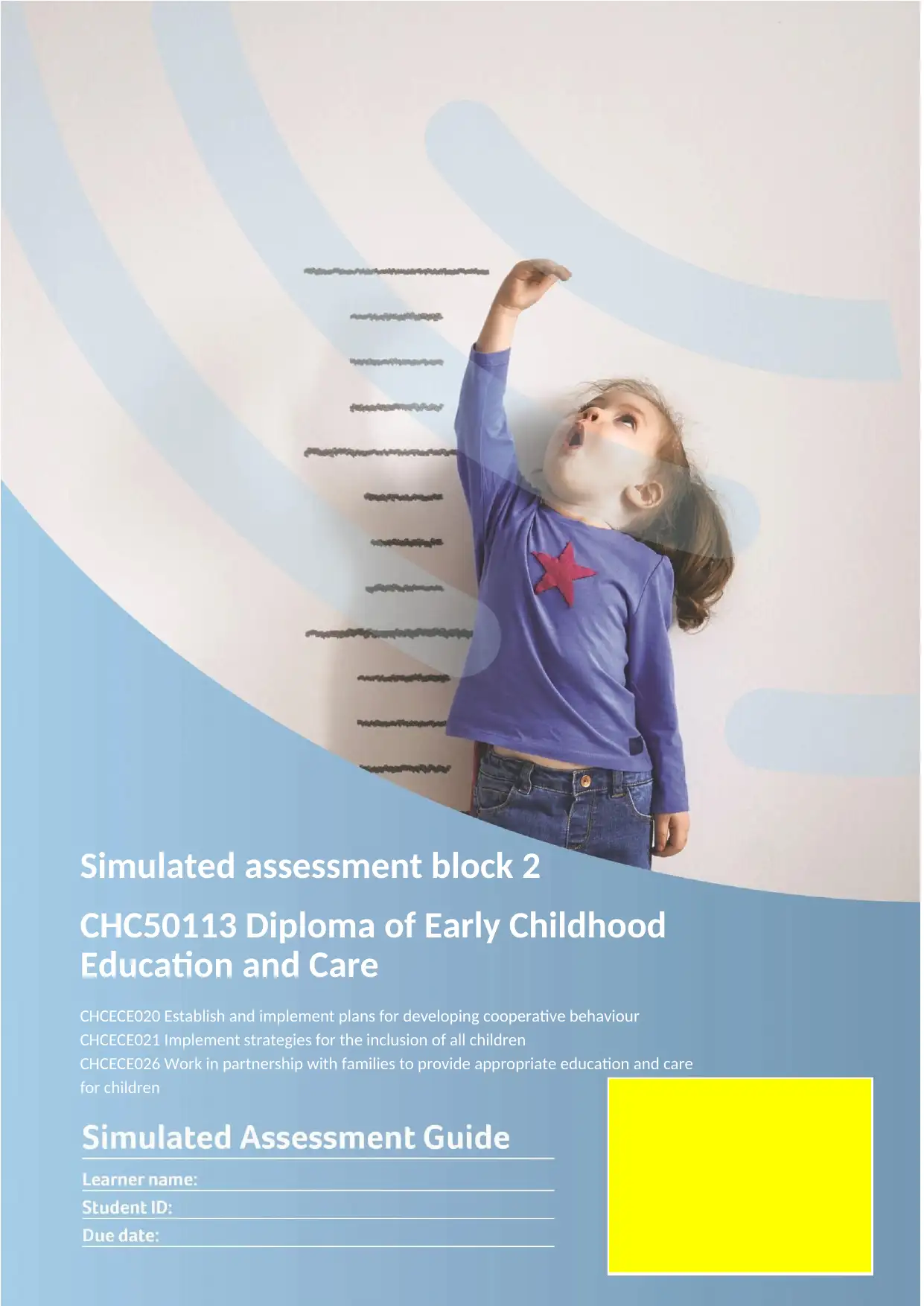
Simulated assessment block 2
CHC50113 Diploma of Early Childhood
Education and Care
CHCECE020 Establish and implement plans for developing cooperative behaviour
CHCECE021 Implement strategies for the inclusion of all children
CHCECE026 Work in partnership with families to provide appropriate education and care
for children
CHC50113 Diploma of Early Childhood
Education and Care
CHCECE020 Establish and implement plans for developing cooperative behaviour
CHCECE021 Implement strategies for the inclusion of all children
CHCECE026 Work in partnership with families to provide appropriate education and care
for children
Paraphrase This Document
Need a fresh take? Get an instant paraphrase of this document with our AI Paraphraser
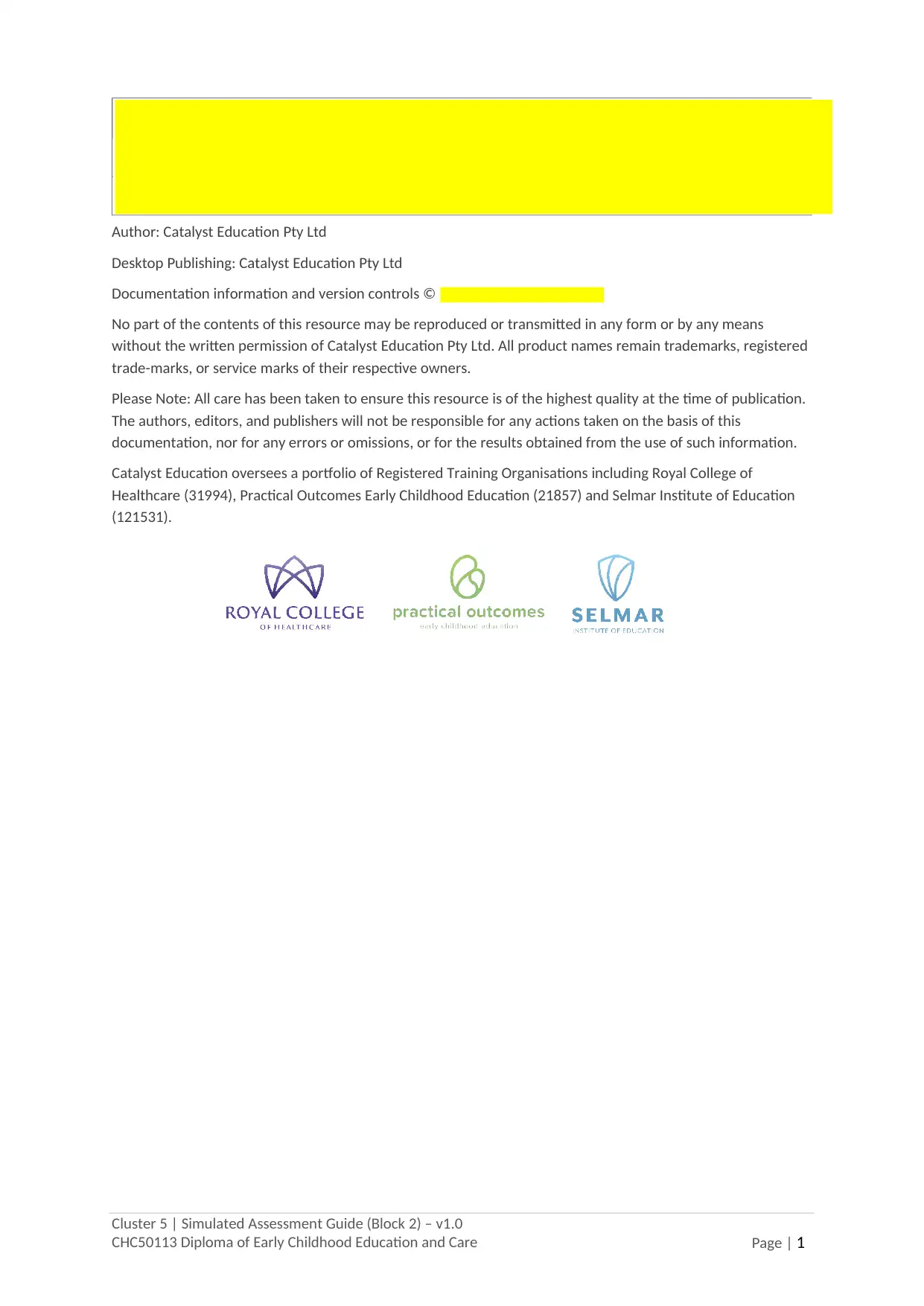
Cluster 5 | Simulated Assessment Guide (Block 2) – v1.0
CHC50113 Diploma of Early Childhood Education and Care Page | 1
Author: Catalyst Education Pty Ltd
Desktop Publishing: Catalyst Education Pty Ltd
Documentation information and version controls ©
No part of the contents of this resource may be reproduced or transmitted in any form or by any means
without the written permission of Catalyst Education Pty Ltd. All product names remain trademarks, registered
trade-marks, or service marks of their respective owners.
Please Note: All care has been taken to ensure this resource is of the highest quality at the time of publication.
The authors, editors, and publishers will not be responsible for any actions taken on the basis of this
documentation, nor for any errors or omissions, or for the results obtained from the use of such information.
Catalyst Education oversees a portfolio of Registered Training Organisations including Royal College of
Healthcare (31994), Practical Outcomes Early Childhood Education (21857) and Selmar Institute of Education
(121531).
CHC50113 Diploma of Early Childhood Education and Care Page | 1
Author: Catalyst Education Pty Ltd
Desktop Publishing: Catalyst Education Pty Ltd
Documentation information and version controls ©
No part of the contents of this resource may be reproduced or transmitted in any form or by any means
without the written permission of Catalyst Education Pty Ltd. All product names remain trademarks, registered
trade-marks, or service marks of their respective owners.
Please Note: All care has been taken to ensure this resource is of the highest quality at the time of publication.
The authors, editors, and publishers will not be responsible for any actions taken on the basis of this
documentation, nor for any errors or omissions, or for the results obtained from the use of such information.
Catalyst Education oversees a portfolio of Registered Training Organisations including Royal College of
Healthcare (31994), Practical Outcomes Early Childhood Education (21857) and Selmar Institute of Education
(121531).
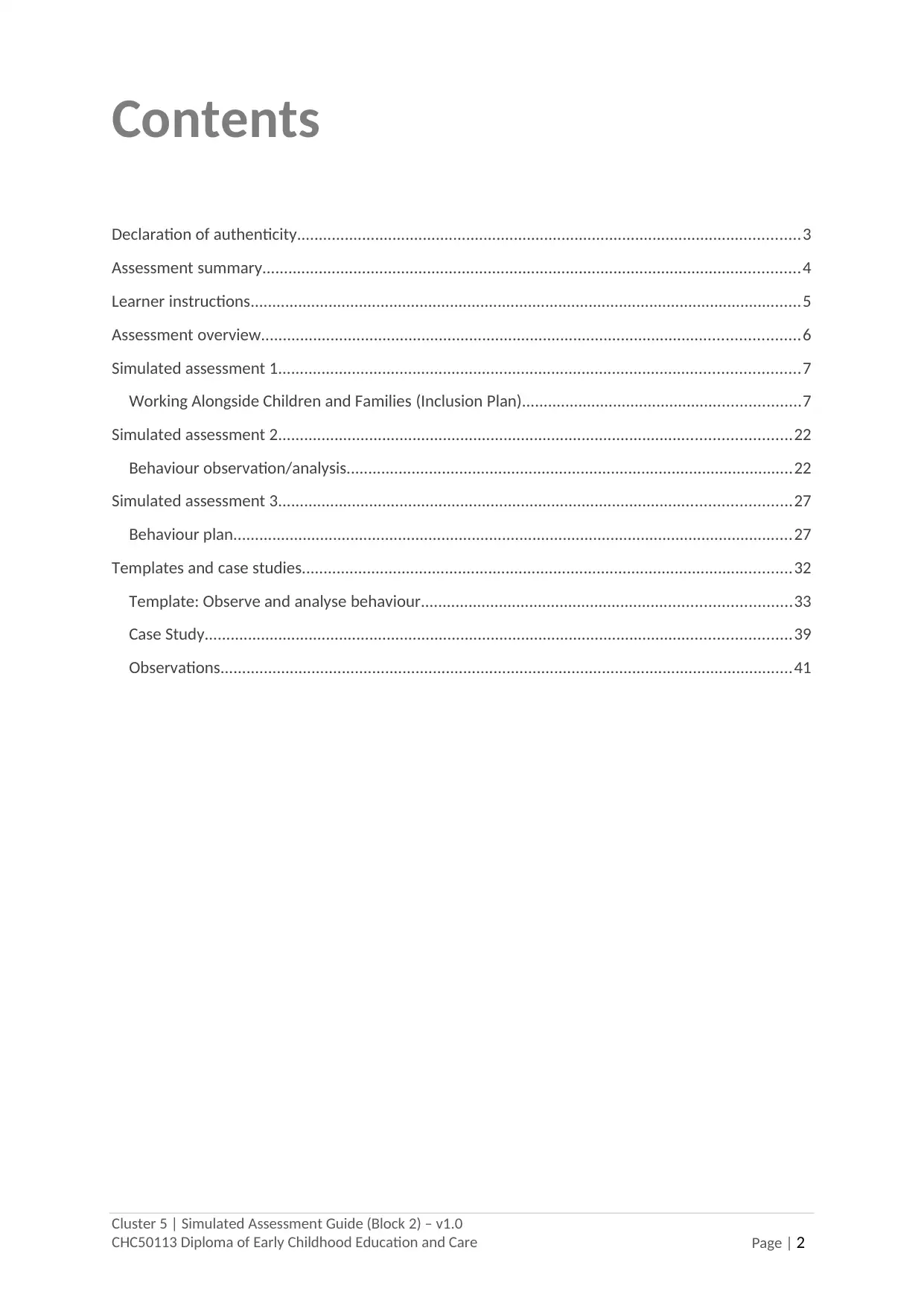
Cluster 5 | Simulated Assessment Guide (Block 2) – v1.0
CHC50113 Diploma of Early Childhood Education and Care Page | 2
Contents
Declaration of authenticity....................................................................................................................3
Assessment summary............................................................................................................................4
Learner instructions...............................................................................................................................5
Assessment overview............................................................................................................................6
Simulated assessment 1........................................................................................................................7
Working Alongside Children and Families (Inclusion Plan)................................................................7
Simulated assessment 2......................................................................................................................22
Behaviour observation/analysis.......................................................................................................22
Simulated assessment 3......................................................................................................................27
Behaviour plan.................................................................................................................................27
Templates and case studies.................................................................................................................32
Template: Observe and analyse behaviour.....................................................................................33
Case Study.......................................................................................................................................39
Observations....................................................................................................................................41
CHC50113 Diploma of Early Childhood Education and Care Page | 2
Contents
Declaration of authenticity....................................................................................................................3
Assessment summary............................................................................................................................4
Learner instructions...............................................................................................................................5
Assessment overview............................................................................................................................6
Simulated assessment 1........................................................................................................................7
Working Alongside Children and Families (Inclusion Plan)................................................................7
Simulated assessment 2......................................................................................................................22
Behaviour observation/analysis.......................................................................................................22
Simulated assessment 3......................................................................................................................27
Behaviour plan.................................................................................................................................27
Templates and case studies.................................................................................................................32
Template: Observe and analyse behaviour.....................................................................................33
Case Study.......................................................................................................................................39
Observations....................................................................................................................................41
⊘ This is a preview!⊘
Do you want full access?
Subscribe today to unlock all pages.

Trusted by 1+ million students worldwide
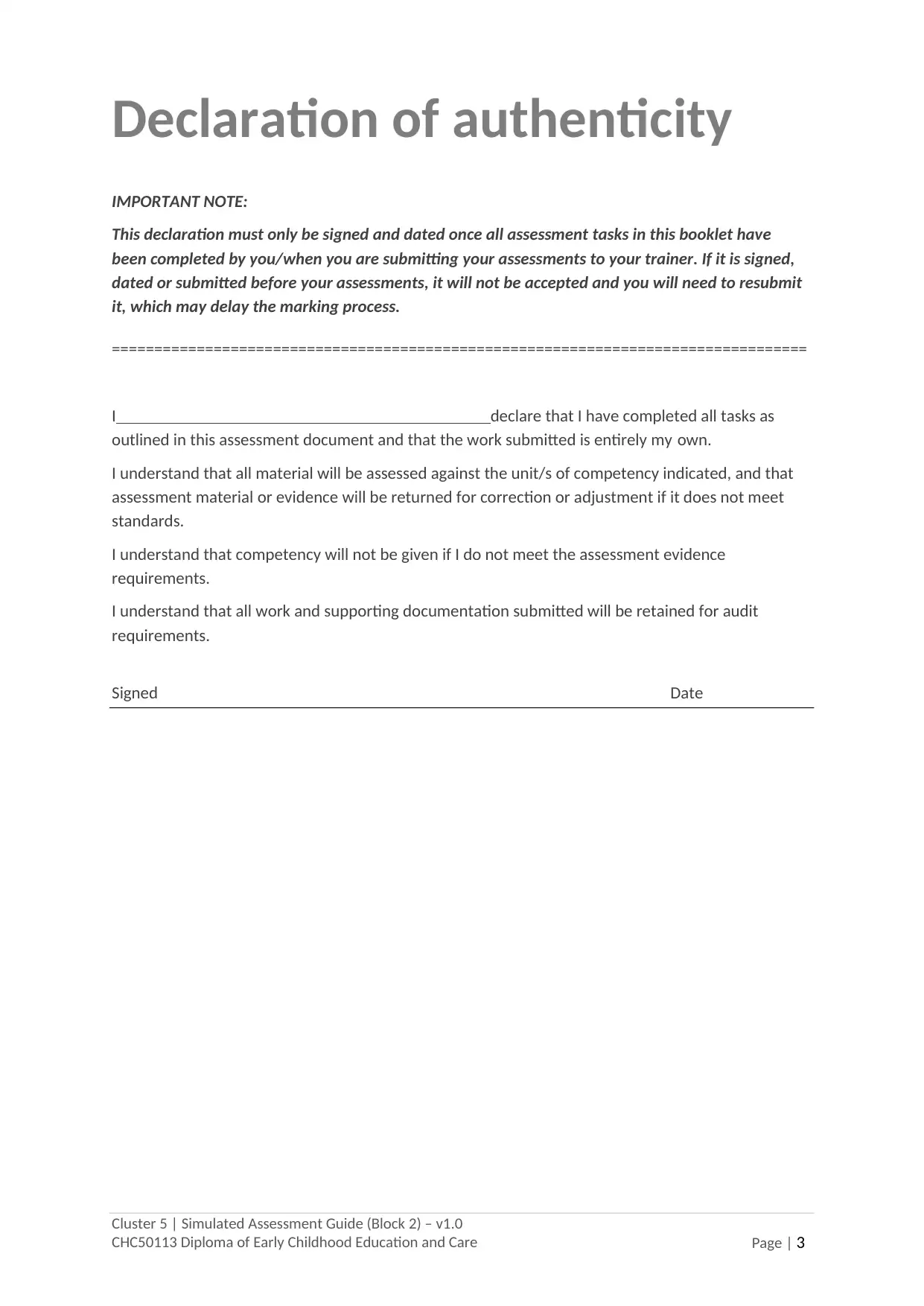
Cluster 5 | Simulated Assessment Guide (Block 2) – v1.0
CHC50113 Diploma of Early Childhood Education and Care Page | 3
Declaration of authenticity
IMPORTANT NOTE:
This declaration must only be signed and dated once all assessment tasks in this booklet have
been completed by you/when you are submitting your assessments to your trainer. If it is signed,
dated or submitted before your assessments, it will not be accepted and you will need to resubmit
it, which may delay the marking process.
==================================================================================
I declare that I have completed all tasks as
outlined in this assessment document and that the work submitted is entirely my own.
I understand that all material will be assessed against the unit/s of competency indicated, and that
assessment material or evidence will be returned for correction or adjustment if it does not meet
standards.
I understand that competency will not be given if I do not meet the assessment evidence
requirements.
I understand that all work and supporting documentation submitted will be retained for audit
requirements.
Signed Date
CHC50113 Diploma of Early Childhood Education and Care Page | 3
Declaration of authenticity
IMPORTANT NOTE:
This declaration must only be signed and dated once all assessment tasks in this booklet have
been completed by you/when you are submitting your assessments to your trainer. If it is signed,
dated or submitted before your assessments, it will not be accepted and you will need to resubmit
it, which may delay the marking process.
==================================================================================
I declare that I have completed all tasks as
outlined in this assessment document and that the work submitted is entirely my own.
I understand that all material will be assessed against the unit/s of competency indicated, and that
assessment material or evidence will be returned for correction or adjustment if it does not meet
standards.
I understand that competency will not be given if I do not meet the assessment evidence
requirements.
I understand that all work and supporting documentation submitted will be retained for audit
requirements.
Signed Date
Paraphrase This Document
Need a fresh take? Get an instant paraphrase of this document with our AI Paraphraser
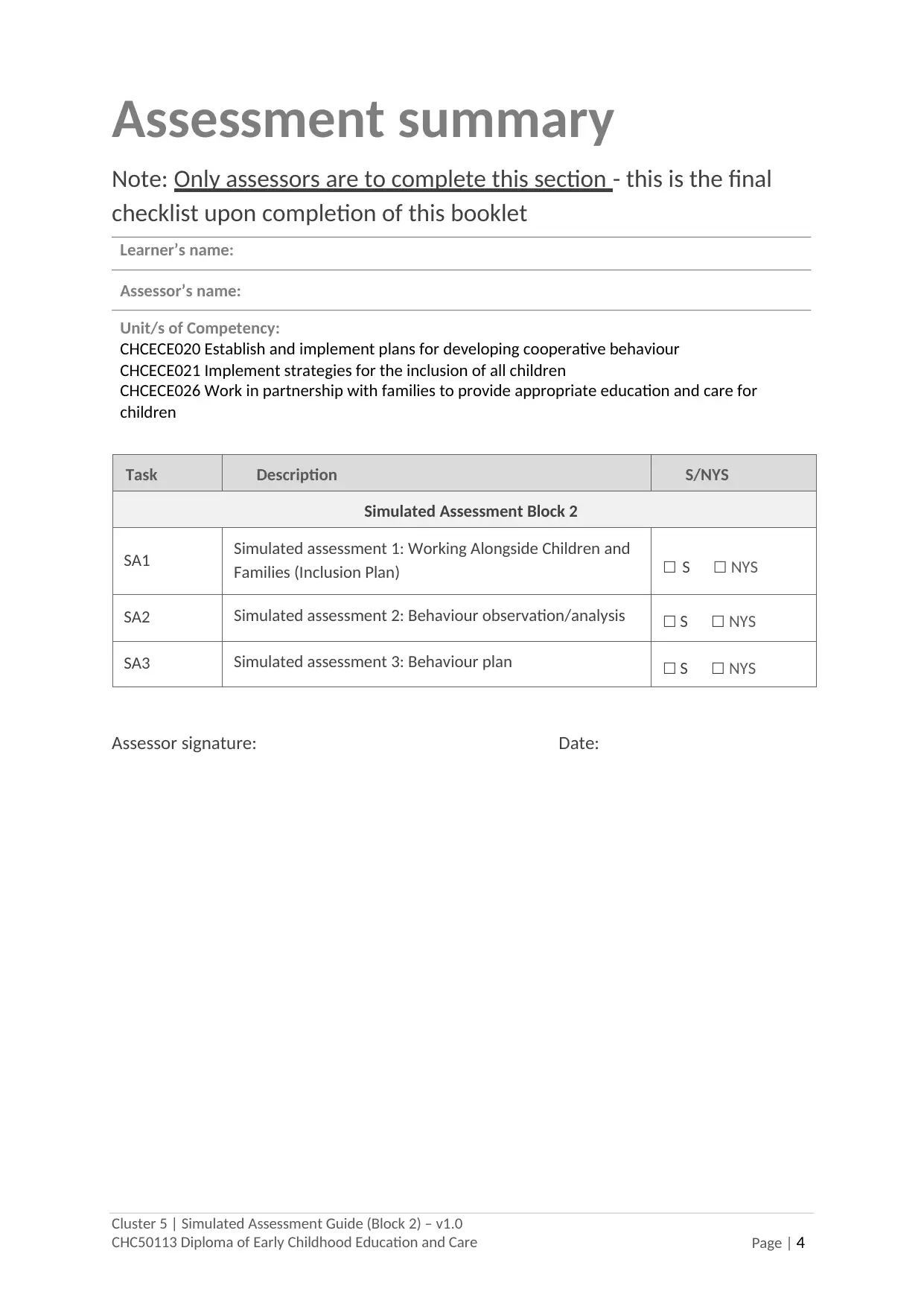
Cluster 5 | Simulated Assessment Guide (Block 2) – v1.0
CHC50113 Diploma of Early Childhood Education and Care Page | 4
Assessment summary
Note: Only assessors are to complete this section - this is the final
checklist upon completion of this booklet
Learner’s name:
Assessor’s name:
Unit/s of Competency:
CHCECE020 Establish and implement plans for developing cooperative behaviour
CHCECE021 Implement strategies for the inclusion of all children
CHCECE026 Work in partnership with families to provide appropriate education and care for
children
Task Description S/NYS
Simulated Assessment Block 2
SA1 Simulated assessment 1: Working Alongside Children and
Families (Inclusion Plan) ☐ S ☐ NYS
SA2 Simulated assessment 2: Behaviour observation/analysis ☐ S ☐ NYS
SA3 Simulated assessment 3: Behaviour plan ☐ S ☐ NYS
Assessor signature: Date:
CHC50113 Diploma of Early Childhood Education and Care Page | 4
Assessment summary
Note: Only assessors are to complete this section - this is the final
checklist upon completion of this booklet
Learner’s name:
Assessor’s name:
Unit/s of Competency:
CHCECE020 Establish and implement plans for developing cooperative behaviour
CHCECE021 Implement strategies for the inclusion of all children
CHCECE026 Work in partnership with families to provide appropriate education and care for
children
Task Description S/NYS
Simulated Assessment Block 2
SA1 Simulated assessment 1: Working Alongside Children and
Families (Inclusion Plan) ☐ S ☐ NYS
SA2 Simulated assessment 2: Behaviour observation/analysis ☐ S ☐ NYS
SA3 Simulated assessment 3: Behaviour plan ☐ S ☐ NYS
Assessor signature: Date:
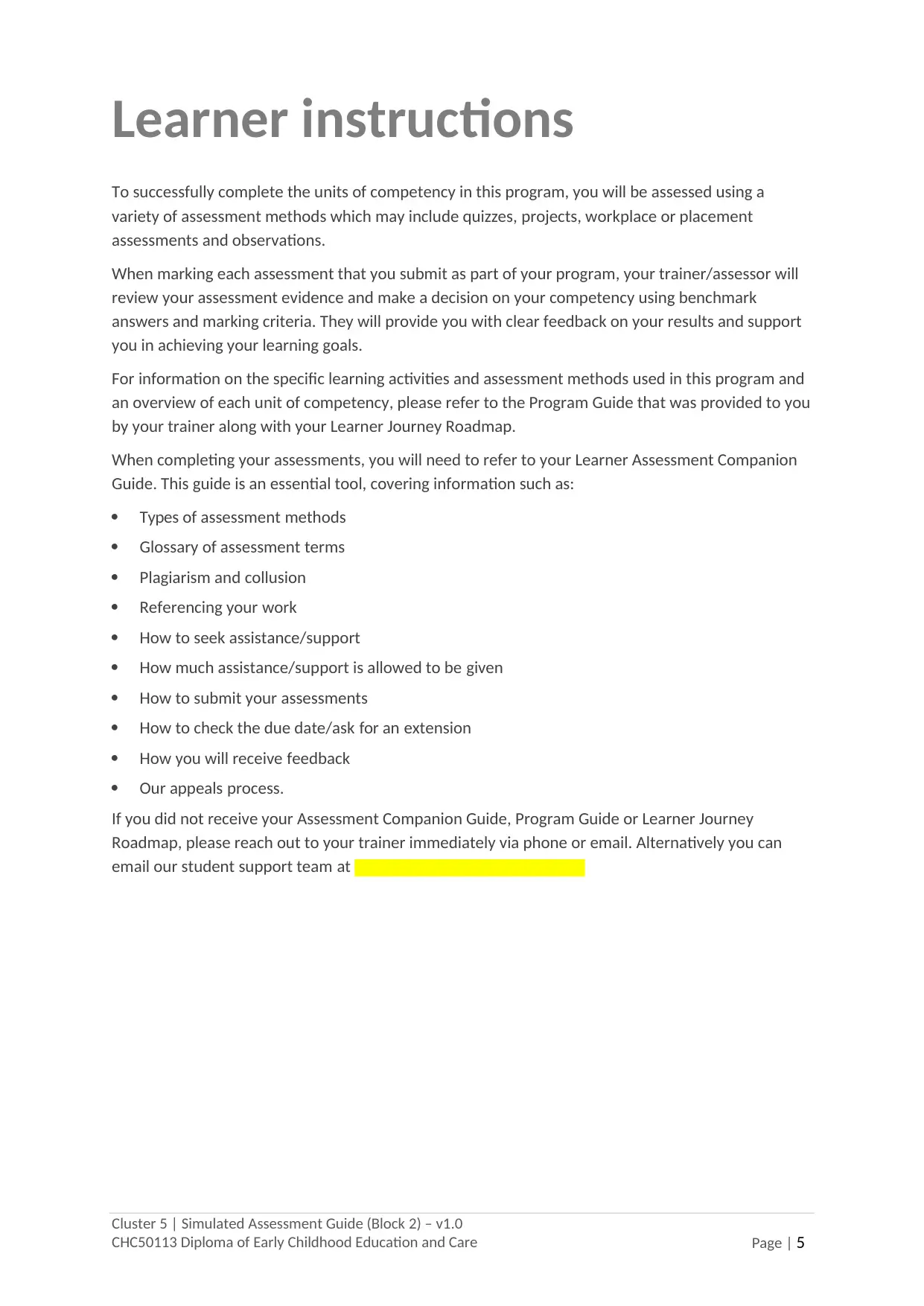
Cluster 5 | Simulated Assessment Guide (Block 2) – v1.0
CHC50113 Diploma of Early Childhood Education and Care Page | 5
Learner instructions
To successfully complete the units of competency in this program, you will be assessed using a
variety of assessment methods which may include quizzes, projects, workplace or placement
assessments and observations.
When marking each assessment that you submit as part of your program, your trainer/assessor will
review your assessment evidence and make a decision on your competency using benchmark
answers and marking criteria. They will provide you with clear feedback on your results and support
you in achieving your learning goals.
For information on the specific learning activities and assessment methods used in this program and
an overview of each unit of competency, please refer to the Program Guide that was provided to you
by your trainer along with your Learner Journey Roadmap.
When completing your assessments, you will need to refer to your Learner Assessment Companion
Guide. This guide is an essential tool, covering information such as:
Types of assessment methods
Glossary of assessment terms
Plagiarism and collusion
Referencing your work
How to seek assistance/support
How much assistance/support is allowed to be given
How to submit your assessments
How to check the due date/ask for an extension
How you will receive feedback
Our appeals process.
If you did not receive your Assessment Companion Guide, Program Guide or Learner Journey
Roadmap, please reach out to your trainer immediately via phone or email. Alternatively you can
email our student support team at
CHC50113 Diploma of Early Childhood Education and Care Page | 5
Learner instructions
To successfully complete the units of competency in this program, you will be assessed using a
variety of assessment methods which may include quizzes, projects, workplace or placement
assessments and observations.
When marking each assessment that you submit as part of your program, your trainer/assessor will
review your assessment evidence and make a decision on your competency using benchmark
answers and marking criteria. They will provide you with clear feedback on your results and support
you in achieving your learning goals.
For information on the specific learning activities and assessment methods used in this program and
an overview of each unit of competency, please refer to the Program Guide that was provided to you
by your trainer along with your Learner Journey Roadmap.
When completing your assessments, you will need to refer to your Learner Assessment Companion
Guide. This guide is an essential tool, covering information such as:
Types of assessment methods
Glossary of assessment terms
Plagiarism and collusion
Referencing your work
How to seek assistance/support
How much assistance/support is allowed to be given
How to submit your assessments
How to check the due date/ask for an extension
How you will receive feedback
Our appeals process.
If you did not receive your Assessment Companion Guide, Program Guide or Learner Journey
Roadmap, please reach out to your trainer immediately via phone or email. Alternatively you can
email our student support team at
⊘ This is a preview!⊘
Do you want full access?
Subscribe today to unlock all pages.

Trusted by 1+ million students worldwide
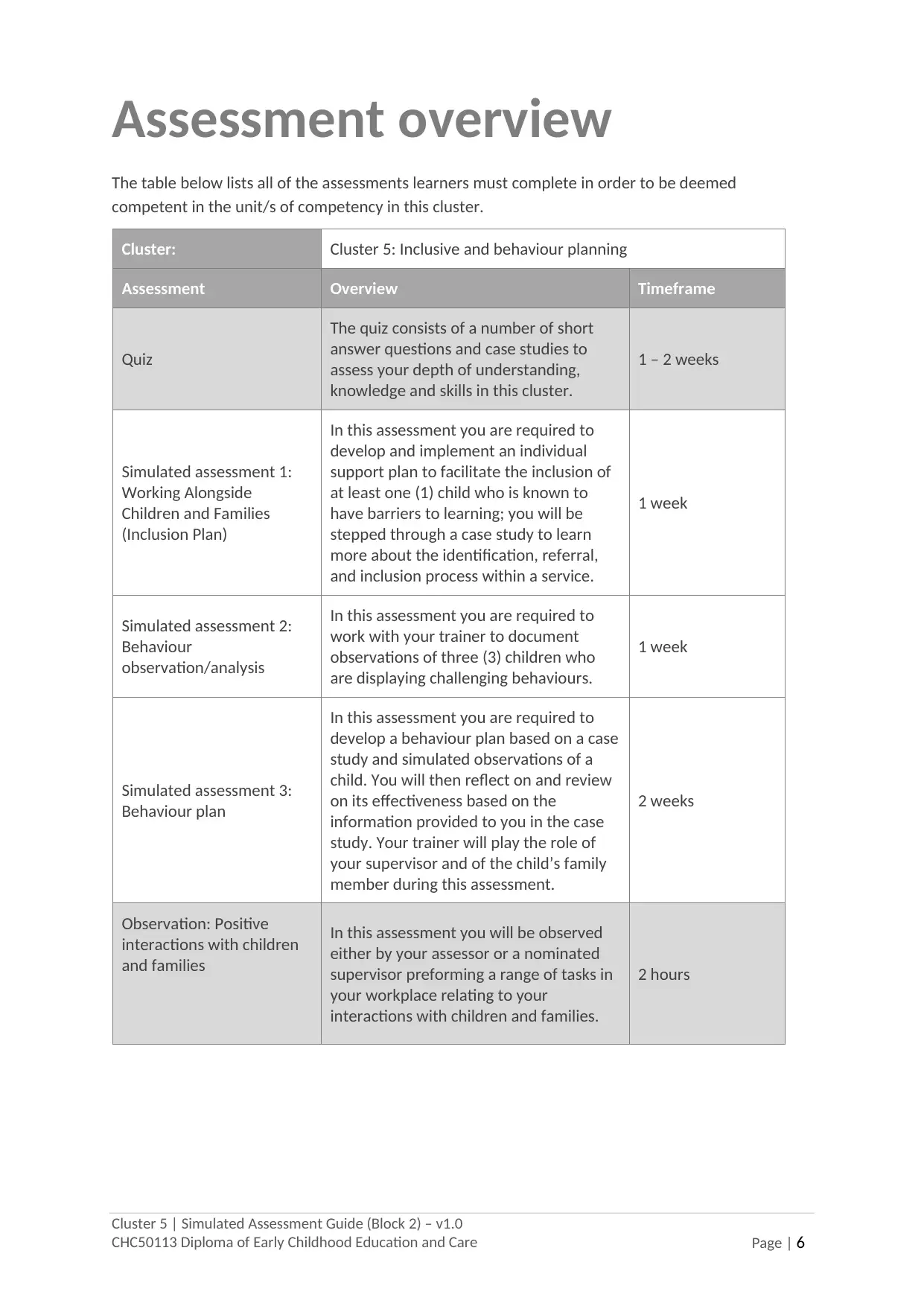
Cluster 5 | Simulated Assessment Guide (Block 2) – v1.0
CHC50113 Diploma of Early Childhood Education and Care Page | 6
Assessment overview
The table below lists all of the assessments learners must complete in order to be deemed
competent in the unit/s of competency in this cluster.
Cluster: Cluster 5: Inclusive and behaviour planning
Assessment Overview Timeframe
Quiz
The quiz consists of a number of short
answer questions and case studies to
assess your depth of understanding,
knowledge and skills in this cluster.
1 – 2 weeks
Simulated assessment 1:
Working Alongside
Children and Families
(Inclusion Plan)
In this assessment you are required to
develop and implement an individual
support plan to facilitate the inclusion of
at least one (1) child who is known to
have barriers to learning; you will be
stepped through a case study to learn
more about the identification, referral,
and inclusion process within a service.
1 week
Simulated assessment 2:
Behaviour
observation/analysis
In this assessment you are required to
work with your trainer to document
observations of three (3) children who
are displaying challenging behaviours.
1 week
Simulated assessment 3:
Behaviour plan
In this assessment you are required to
develop a behaviour plan based on a case
study and simulated observations of a
child. You will then reflect on and review
on its effectiveness based on the
information provided to you in the case
study. Your trainer will play the role of
your supervisor and of the child’s family
member during this assessment.
2 weeks
Observation: Positive
interactions with children
and families
In this assessment you will be observed
either by your assessor or a nominated
supervisor preforming a range of tasks in
your workplace relating to your
interactions with children and families.
2 hours
CHC50113 Diploma of Early Childhood Education and Care Page | 6
Assessment overview
The table below lists all of the assessments learners must complete in order to be deemed
competent in the unit/s of competency in this cluster.
Cluster: Cluster 5: Inclusive and behaviour planning
Assessment Overview Timeframe
Quiz
The quiz consists of a number of short
answer questions and case studies to
assess your depth of understanding,
knowledge and skills in this cluster.
1 – 2 weeks
Simulated assessment 1:
Working Alongside
Children and Families
(Inclusion Plan)
In this assessment you are required to
develop and implement an individual
support plan to facilitate the inclusion of
at least one (1) child who is known to
have barriers to learning; you will be
stepped through a case study to learn
more about the identification, referral,
and inclusion process within a service.
1 week
Simulated assessment 2:
Behaviour
observation/analysis
In this assessment you are required to
work with your trainer to document
observations of three (3) children who
are displaying challenging behaviours.
1 week
Simulated assessment 3:
Behaviour plan
In this assessment you are required to
develop a behaviour plan based on a case
study and simulated observations of a
child. You will then reflect on and review
on its effectiveness based on the
information provided to you in the case
study. Your trainer will play the role of
your supervisor and of the child’s family
member during this assessment.
2 weeks
Observation: Positive
interactions with children
and families
In this assessment you will be observed
either by your assessor or a nominated
supervisor preforming a range of tasks in
your workplace relating to your
interactions with children and families.
2 hours
Paraphrase This Document
Need a fresh take? Get an instant paraphrase of this document with our AI Paraphraser
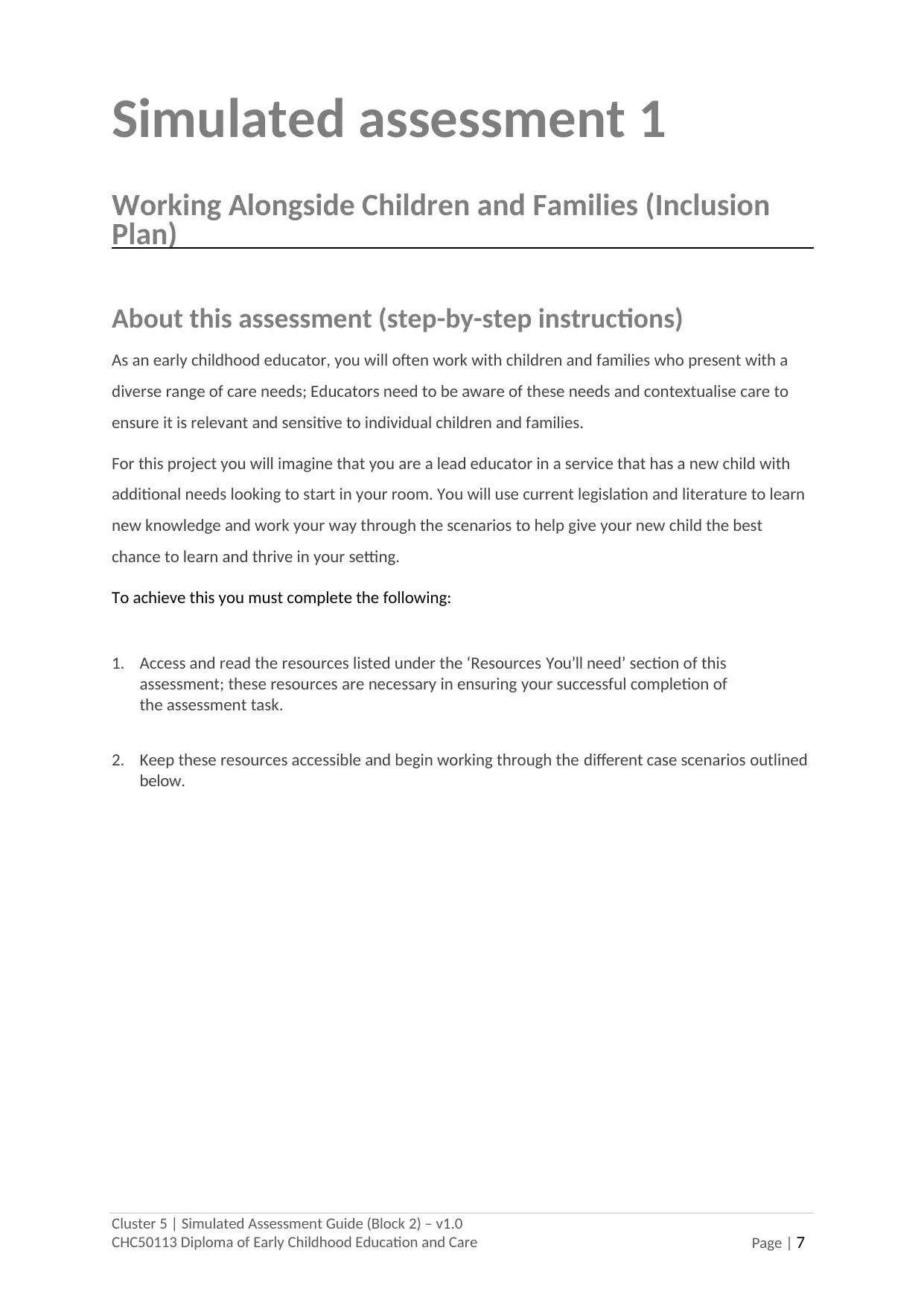
Cluster 5 | Simulated Assessment Guide (Block 2) – v1.0
CHC50113 Diploma of Early Childhood Education and Care Page | 7
Simulated assessment 1
Working Alongside Children and Families (Inclusion
Plan)
About this assessment (step-by-step instructions)
As an early childhood educator, you will often work with children and families who present with a
diverse range of care needs; Educators need to be aware of these needs and contextualise care to
ensure it is relevant and sensitive to individual children and families.
For this project you will imagine that you are a lead educator in a service that has a new child with
additional needs looking to start in your room. You will use current legislation and literature to learn
new knowledge and work your way through the scenarios to help give your new child the best
chance to learn and thrive in your setting.
To achieve this you must complete the following:
1. Access and read the resources listed under the ‘Resources You’ll need’ section of this
assessment; these resources are necessary in ensuring your successful completion of
the assessment task.
2. Keep these resources accessible and begin working through the different case scenarios outlined
below.
CHC50113 Diploma of Early Childhood Education and Care Page | 7
Simulated assessment 1
Working Alongside Children and Families (Inclusion
Plan)
About this assessment (step-by-step instructions)
As an early childhood educator, you will often work with children and families who present with a
diverse range of care needs; Educators need to be aware of these needs and contextualise care to
ensure it is relevant and sensitive to individual children and families.
For this project you will imagine that you are a lead educator in a service that has a new child with
additional needs looking to start in your room. You will use current legislation and literature to learn
new knowledge and work your way through the scenarios to help give your new child the best
chance to learn and thrive in your setting.
To achieve this you must complete the following:
1. Access and read the resources listed under the ‘Resources You’ll need’ section of this
assessment; these resources are necessary in ensuring your successful completion of
the assessment task.
2. Keep these resources accessible and begin working through the different case scenarios outlined
below.
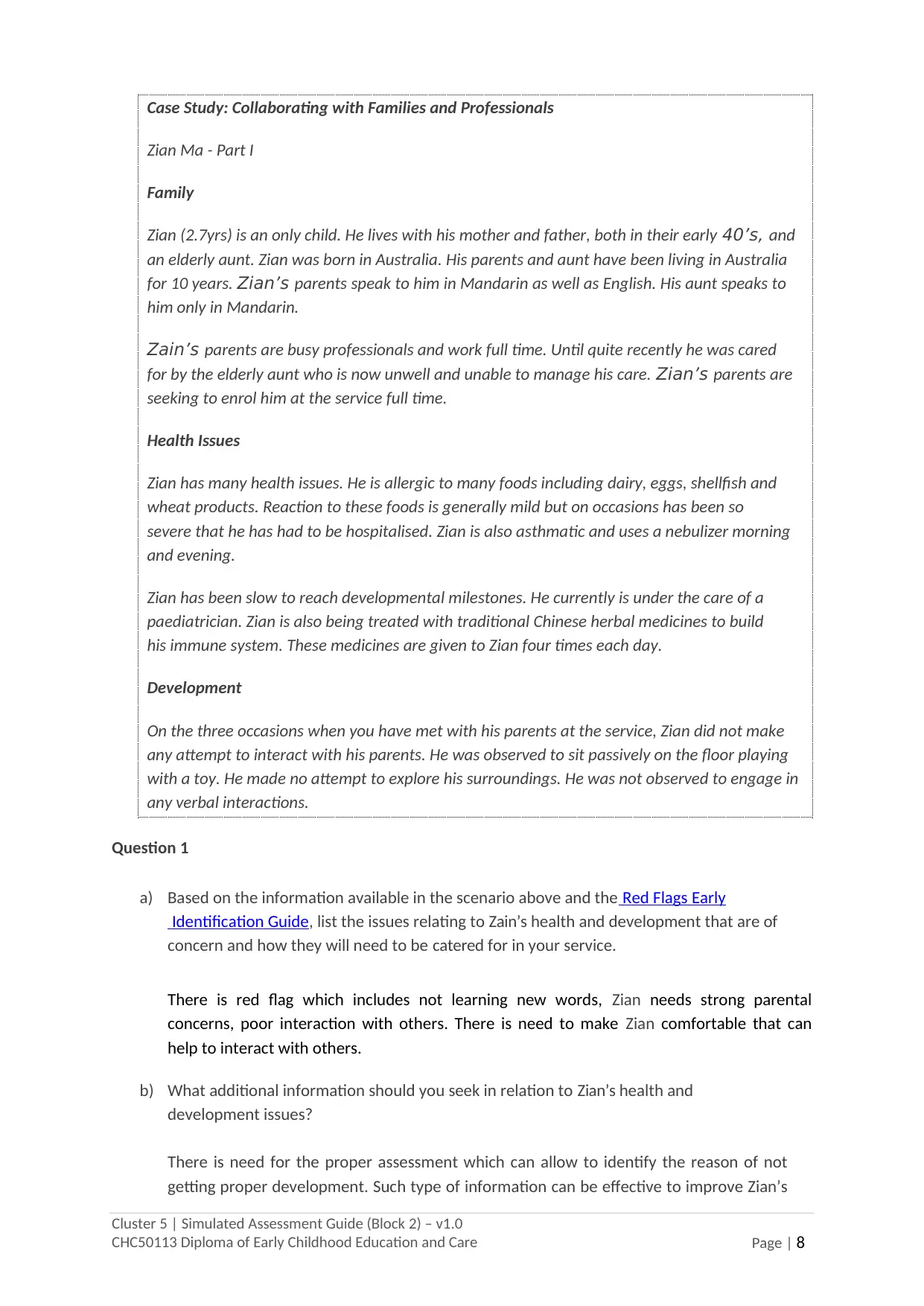
Cluster 5 | Simulated Assessment Guide (Block 2) – v1.0
CHC50113 Diploma of Early Childhood Education and Care Page | 8
Case Study: Collaborating with Families and Professionals
Zian Ma - Part I
Family
Zian (2.7yrs) is an only child. He lives with his mother and father, both in their early 40’s, and
an elderly aunt. Zian was born in Australia. His parents and aunt have been living in Australia
for 10 years. Zian’s parents speak to him in Mandarin as well as English. His aunt speaks to
him only in Mandarin.
Zain’s parents are busy professionals and work full time. Until quite recently he was cared
for by the elderly aunt who is now unwell and unable to manage his care. Zian’s parents are
seeking to enrol him at the service full time.
Health Issues
Zian has many health issues. He is allergic to many foods including dairy, eggs, shellfish and
wheat products. Reaction to these foods is generally mild but on occasions has been so
severe that he has had to be hospitalised. Zian is also asthmatic and uses a nebulizer morning
and evening.
Zian has been slow to reach developmental milestones. He currently is under the care of a
paediatrician. Zian is also being treated with traditional Chinese herbal medicines to build
his immune system. These medicines are given to Zian four times each day.
Development
On the three occasions when you have met with his parents at the service, Zian did not make
any attempt to interact with his parents. He was observed to sit passively on the floor playing
with a toy. He made no attempt to explore his surroundings. He was not observed to engage in
any verbal interactions.
Question 1
a) Based on the information available in the scenario above and the Red Flags Early
Identification Guide, list the issues relating to Zain’s health and development that are of
concern and how they will need to be catered for in your service.
There is red flag which includes not learning new words, Zian needs strong parental
concerns, poor interaction with others. There is need to make Zian comfortable that can
help to interact with others.
b) What additional information should you seek in relation to Zian’s health and
development issues?
There is need for the proper assessment which can allow to identify the reason of not
getting proper development. Such type of information can be effective to improve Zian’s
CHC50113 Diploma of Early Childhood Education and Care Page | 8
Case Study: Collaborating with Families and Professionals
Zian Ma - Part I
Family
Zian (2.7yrs) is an only child. He lives with his mother and father, both in their early 40’s, and
an elderly aunt. Zian was born in Australia. His parents and aunt have been living in Australia
for 10 years. Zian’s parents speak to him in Mandarin as well as English. His aunt speaks to
him only in Mandarin.
Zain’s parents are busy professionals and work full time. Until quite recently he was cared
for by the elderly aunt who is now unwell and unable to manage his care. Zian’s parents are
seeking to enrol him at the service full time.
Health Issues
Zian has many health issues. He is allergic to many foods including dairy, eggs, shellfish and
wheat products. Reaction to these foods is generally mild but on occasions has been so
severe that he has had to be hospitalised. Zian is also asthmatic and uses a nebulizer morning
and evening.
Zian has been slow to reach developmental milestones. He currently is under the care of a
paediatrician. Zian is also being treated with traditional Chinese herbal medicines to build
his immune system. These medicines are given to Zian four times each day.
Development
On the three occasions when you have met with his parents at the service, Zian did not make
any attempt to interact with his parents. He was observed to sit passively on the floor playing
with a toy. He made no attempt to explore his surroundings. He was not observed to engage in
any verbal interactions.
Question 1
a) Based on the information available in the scenario above and the Red Flags Early
Identification Guide, list the issues relating to Zain’s health and development that are of
concern and how they will need to be catered for in your service.
There is red flag which includes not learning new words, Zian needs strong parental
concerns, poor interaction with others. There is need to make Zian comfortable that can
help to interact with others.
b) What additional information should you seek in relation to Zian’s health and
development issues?
There is need for the proper assessment which can allow to identify the reason of not
getting proper development. Such type of information can be effective to improve Zian’s
⊘ This is a preview!⊘
Do you want full access?
Subscribe today to unlock all pages.

Trusted by 1+ million students worldwide
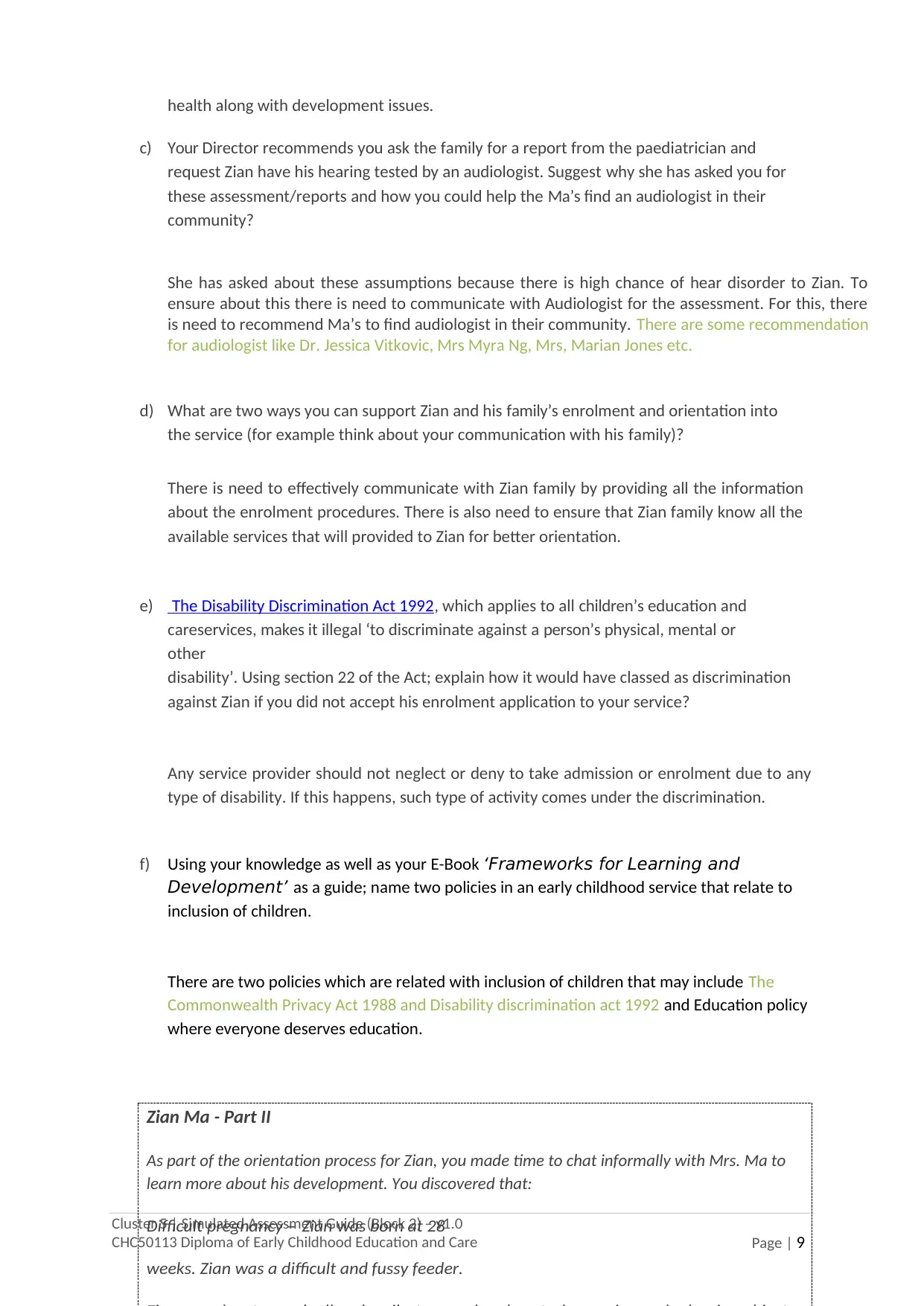
Cluster 5 | Simulated Assessment Guide (Block 2) – v1.0
CHC50113 Diploma of Early Childhood Education and Care Page | 9
health along with development issues.
c) Your Director recommends you ask the family for a report from the paediatrician and
request Zian have his hearing tested by an audiologist. Suggest why she has asked you for
these assessment/reports and how you could help the Ma’s find an audiologist in their
community?
She has asked about these assumptions because there is high chance of hear disorder to Zian. To
ensure about this there is need to communicate with Audiologist for the assessment. For this, there
is need to recommend Ma’s to find audiologist in their community. There are some recommendation
for audiologist like Dr. Jessica Vitkovic, Mrs Myra Ng, Mrs, Marian Jones etc.
d) What are two ways you can support Zian and his family’s enrolment and orientation into
the service (for example think about your communication with his family)?
There is need to effectively communicate with Zian family by providing all the information
about the enrolment procedures. There is also need to ensure that Zian family know all the
available services that will provided to Zian for better orientation.
e) The Disability Discrimination Act 1992, which applies to all children’s education and
careservices, makes it illegal ‘to discriminate against a person’s physical, mental or
other
disability’. Using section 22 of the Act; explain how it would have classed as discrimination
against Zian if you did not accept his enrolment application to your service?
Any service provider should not neglect or deny to take admission or enrolment due to any
type of disability. If this happens, such type of activity comes under the discrimination.
f) Using your knowledge as well as your E-Book ‘Frameworks for Learning and
Development’ as a guide; name two policies in an early childhood service that relate to
inclusion of children.
There are two policies which are related with inclusion of children that may include The
Commonwealth Privacy Act 1988 and Disability discrimination act 1992 and Education policy
where everyone deserves education.
Zian Ma - Part II
As part of the orientation process for Zian, you made time to chat informally with Mrs. Ma to
learn more about his development. You discovered that:
Difficult pregnancy – Zian was born at 28
weeks. Zian was a difficult and fussy feeder.
CHC50113 Diploma of Early Childhood Education and Care Page | 9
health along with development issues.
c) Your Director recommends you ask the family for a report from the paediatrician and
request Zian have his hearing tested by an audiologist. Suggest why she has asked you for
these assessment/reports and how you could help the Ma’s find an audiologist in their
community?
She has asked about these assumptions because there is high chance of hear disorder to Zian. To
ensure about this there is need to communicate with Audiologist for the assessment. For this, there
is need to recommend Ma’s to find audiologist in their community. There are some recommendation
for audiologist like Dr. Jessica Vitkovic, Mrs Myra Ng, Mrs, Marian Jones etc.
d) What are two ways you can support Zian and his family’s enrolment and orientation into
the service (for example think about your communication with his family)?
There is need to effectively communicate with Zian family by providing all the information
about the enrolment procedures. There is also need to ensure that Zian family know all the
available services that will provided to Zian for better orientation.
e) The Disability Discrimination Act 1992, which applies to all children’s education and
careservices, makes it illegal ‘to discriminate against a person’s physical, mental or
other
disability’. Using section 22 of the Act; explain how it would have classed as discrimination
against Zian if you did not accept his enrolment application to your service?
Any service provider should not neglect or deny to take admission or enrolment due to any
type of disability. If this happens, such type of activity comes under the discrimination.
f) Using your knowledge as well as your E-Book ‘Frameworks for Learning and
Development’ as a guide; name two policies in an early childhood service that relate to
inclusion of children.
There are two policies which are related with inclusion of children that may include The
Commonwealth Privacy Act 1988 and Disability discrimination act 1992 and Education policy
where everyone deserves education.
Zian Ma - Part II
As part of the orientation process for Zian, you made time to chat informally with Mrs. Ma to
learn more about his development. You discovered that:
Difficult pregnancy – Zian was born at 28
weeks. Zian was a difficult and fussy feeder.
Paraphrase This Document
Need a fresh take? Get an instant paraphrase of this document with our AI Paraphraser
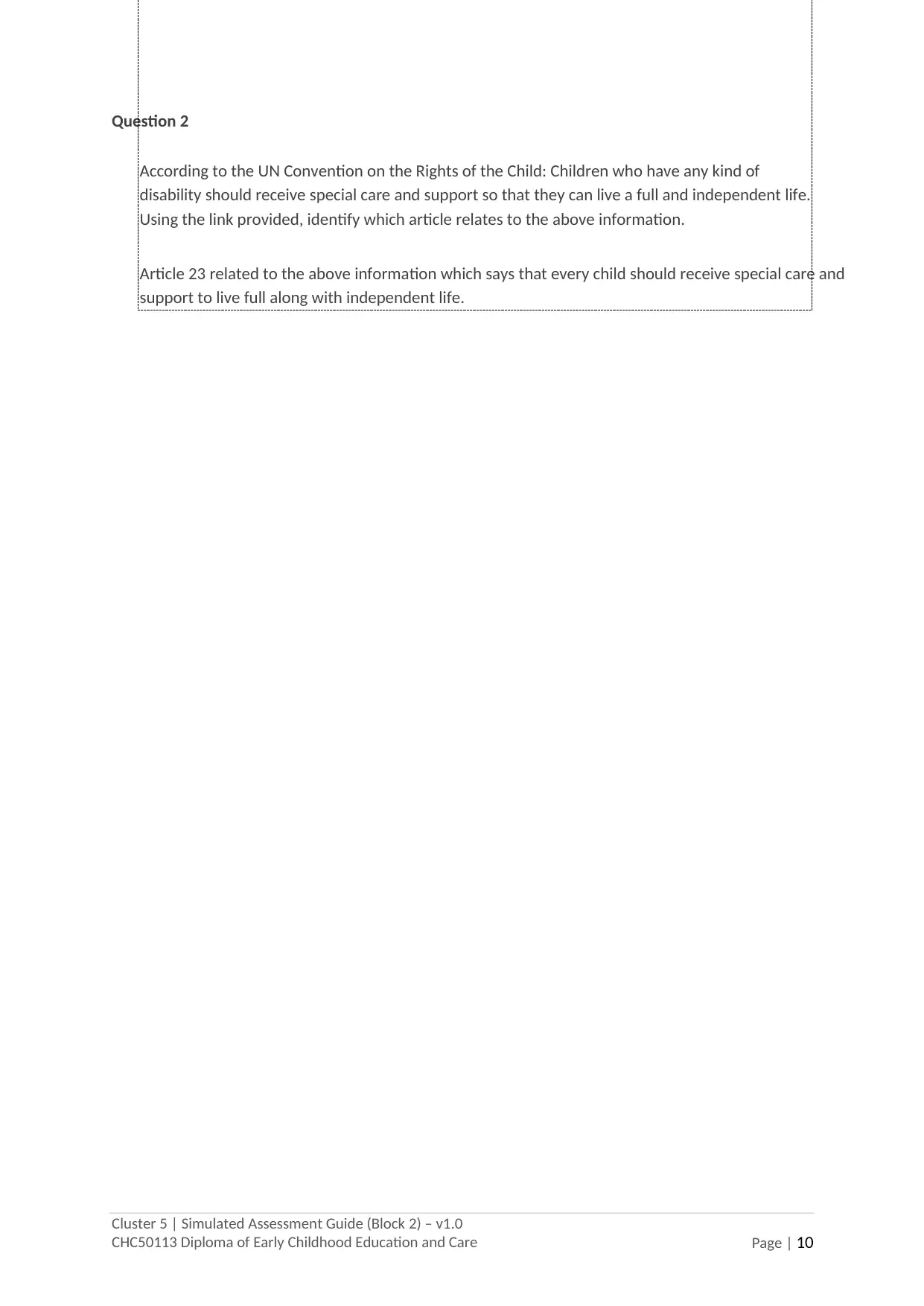
Cluster 5 | Simulated Assessment Guide (Block 2) – v1.0
CHC50113 Diploma of Early Childhood Education and Care Page | 10
Question 2
According to the UN Convention on the Rights of the Child: Children who have any kind of
disability should receive special care and support so that they can live a full and independent life.
Using the link provided, identify which article relates to the above information.
Article 23 related to the above information which says that every child should receive special care and
support to live full along with independent life.
CHC50113 Diploma of Early Childhood Education and Care Page | 10
Question 2
According to the UN Convention on the Rights of the Child: Children who have any kind of
disability should receive special care and support so that they can live a full and independent life.
Using the link provided, identify which article relates to the above information.
Article 23 related to the above information which says that every child should receive special care and
support to live full along with independent life.
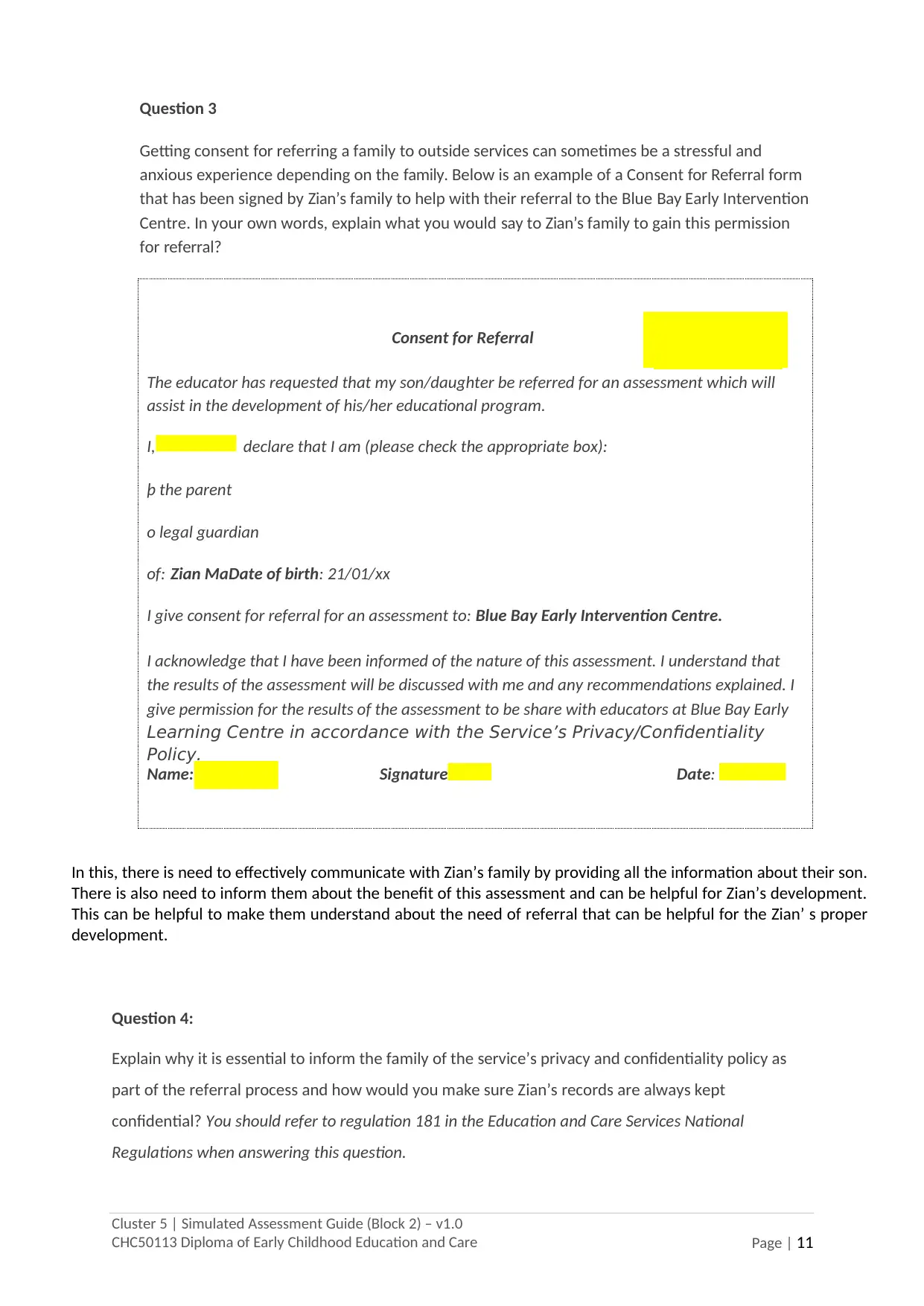
Cluster 5 | Simulated Assessment Guide (Block 2) – v1.0
CHC50113 Diploma of Early Childhood Education and Care Page | 11
Question 3
Getting consent for referring a family to outside services can sometimes be a stressful and
anxious experience depending on the family. Below is an example of a Consent for Referral form
that has been signed by Zian’s family to help with their referral to the Blue Bay Early Intervention
Centre. In your own words, explain what you would say to Zian’s family to gain this permission
for referral?
In this, there is need to effectively communicate with Zian’s family by providing all the information about their son.
There is also need to inform them about the benefit of this assessment and can be helpful for Zian’s development.
This can be helpful to make them understand about the need of referral that can be helpful for the Zian’ s proper
development.
Question 4:
Explain why it is essential to inform the family of the service’s privacy and confidentiality policy as
part of the referral process and how would you make sure Zian’s records are always kept
confidential? You should refer to regulation 181 in the Education and Care Services National
Regulations when answering this question.
Consent for Referral
The educator has requested that my son/daughter be referred for an assessment which will
assist in the development of his/her educational program.
I, declare that I am (please check the appropriate box):
þ the parent
o legal guardian
of: Zian MaDate of birth: 21/01/xx
I give consent for referral for an assessment to: Blue Bay Early Intervention Centre.
I acknowledge that I have been informed of the nature of this assessment. I understand that
the results of the assessment will be discussed with me and any recommendations explained. I
give permission for the results of the assessment to be share with educators at Blue Bay Early
Learning Centre in accordance with the Service’s Privacy/Confidentiality
Policy.
Name: Signature Date:
CHC50113 Diploma of Early Childhood Education and Care Page | 11
Question 3
Getting consent for referring a family to outside services can sometimes be a stressful and
anxious experience depending on the family. Below is an example of a Consent for Referral form
that has been signed by Zian’s family to help with their referral to the Blue Bay Early Intervention
Centre. In your own words, explain what you would say to Zian’s family to gain this permission
for referral?
In this, there is need to effectively communicate with Zian’s family by providing all the information about their son.
There is also need to inform them about the benefit of this assessment and can be helpful for Zian’s development.
This can be helpful to make them understand about the need of referral that can be helpful for the Zian’ s proper
development.
Question 4:
Explain why it is essential to inform the family of the service’s privacy and confidentiality policy as
part of the referral process and how would you make sure Zian’s records are always kept
confidential? You should refer to regulation 181 in the Education and Care Services National
Regulations when answering this question.
Consent for Referral
The educator has requested that my son/daughter be referred for an assessment which will
assist in the development of his/her educational program.
I, declare that I am (please check the appropriate box):
þ the parent
o legal guardian
of: Zian MaDate of birth: 21/01/xx
I give consent for referral for an assessment to: Blue Bay Early Intervention Centre.
I acknowledge that I have been informed of the nature of this assessment. I understand that
the results of the assessment will be discussed with me and any recommendations explained. I
give permission for the results of the assessment to be share with educators at Blue Bay Early
Learning Centre in accordance with the Service’s Privacy/Confidentiality
Policy.
Name: Signature Date:
⊘ This is a preview!⊘
Do you want full access?
Subscribe today to unlock all pages.

Trusted by 1+ million students worldwide
1 out of 57
Related Documents
Your All-in-One AI-Powered Toolkit for Academic Success.
+13062052269
info@desklib.com
Available 24*7 on WhatsApp / Email
![[object Object]](/_next/static/media/star-bottom.7253800d.svg)
Unlock your academic potential
Copyright © 2020–2025 A2Z Services. All Rights Reserved. Developed and managed by ZUCOL.





